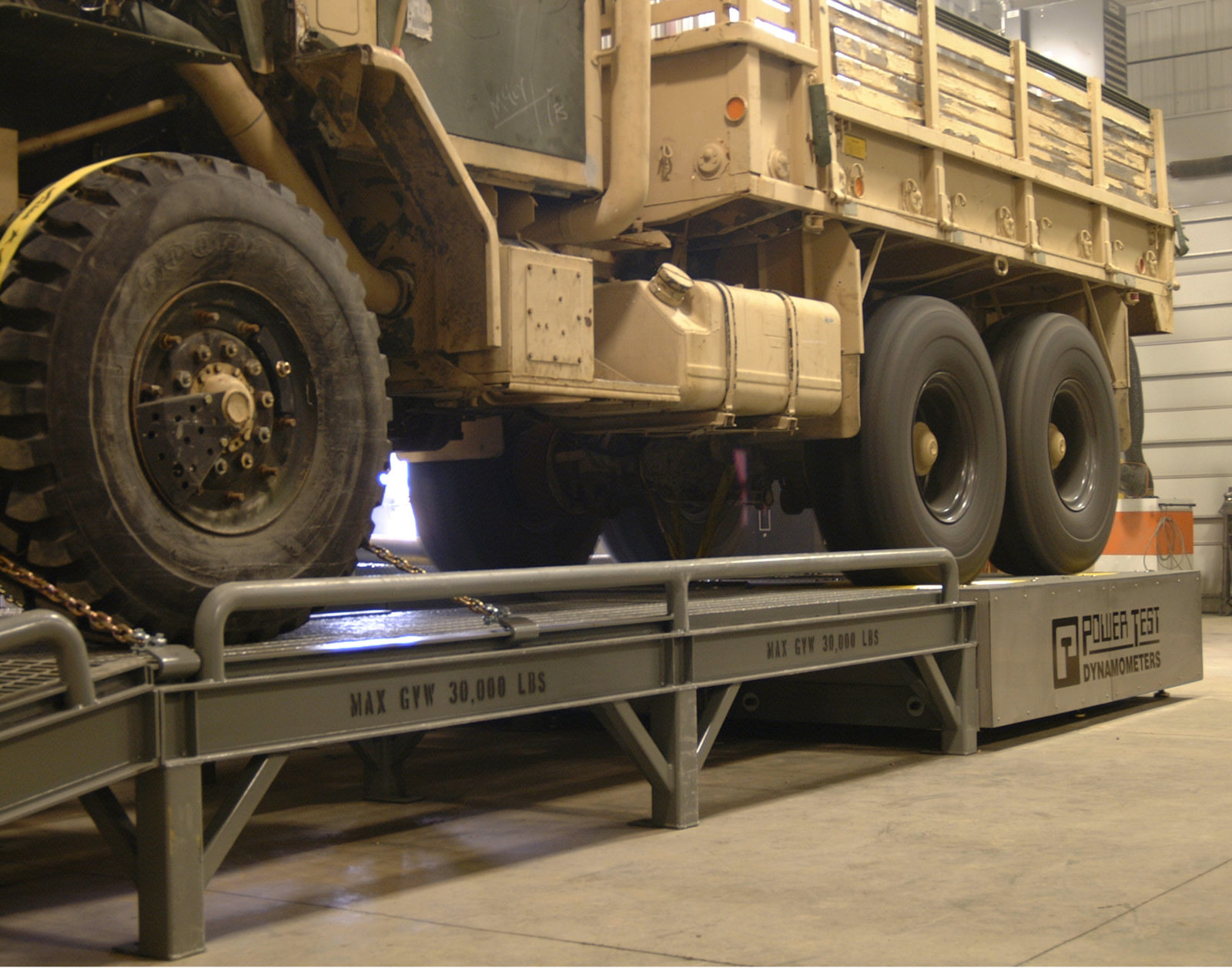Military Applications of Dynamometers and Heavy Equipment Testing Systems
Testing of military vehicle components has long been crucial to ensuring reliable operation in the field. As vehicle technology advances, and as government initiatives seek greater vehicle operating efficiencies, vehicle component testing is even more important.
“Military vehicles are commonly operated in conditions far more adverse than civilian vehicles. Any military vehicle could end up in a theater of operation, so it’s always been imperative that all the engine, transmission and chassis components are fully reliable,” said Shane Classen, senior project manager at Power Test, Inc., a manufacturer of dynamometers, heavy equipment testing systems and related data acquisition and control systems used by the militaries of nations throughout the world. “It’s also extremely important that those testing and data acquisition systems are easy to use, especially as vehicles become more advanced and as governments watch resources more closely,” added Classen, who spent 23 years in the U.S. Marine Corps before joining Power Test.
Today’s military vehicles are increasingly controlled by electronics. And systems to enable self-driving land vehicles with an even greater reliance on electronics are in testing stages. For example, a new generation of ground-based vehicles designed and manufactured by Oshkosh Defense is now in production. The vehicle features a General Motors diesel engine and Allison Transmission, but can be fitted with Oshkosh’s diesel-electric powertrain to improve fuel economy. All Oshkosh vehicles are tested on Power Test equipment before being delivered to military customers.
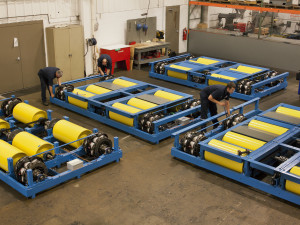 Advances are also being made in vehicle fuel efficiency as military research is seeking ways to further reduce fuel requirements of ground-based vehicles and to lessen the dependence on diesel fuel, which is costly and logistically challenging in the field. Alternatives include hybrid electric engines and hydrogen fuel cells.
Advances are also being made in vehicle fuel efficiency as military research is seeking ways to further reduce fuel requirements of ground-based vehicles and to lessen the dependence on diesel fuel, which is costly and logistically challenging in the field. Alternatives include hybrid electric engines and hydrogen fuel cells.
“There are significant benefits to going electric,” notes Power Test’s Rob Kazmier. “Along with fuel savings and the alleviation of the risks and challenges of transporting diesel fuel, electric motors offer stealth benefits as well. These products provide a significant reduction in noise, heat and exhaust generation that could alert an enemy or guide incoming thermal-targeted missiles.”
No matter what the research focus, test systems such as those manufactured by Power Test bring efficiencies to the process.
“With a multi-axle chassis dynamometer designed for military vehicles, you can test a diesel-powered vehicle and then immediately test a vehicle with an alternative power system in laboratory conditions allowing fully repeatable tests that simulate real driving conditions,” Kazmier said. “You don’t need to have a driver running the vehicles up and down hills at a proving ground, so it’s a lot more efficient. And because the testing is done in a lab, test conditions can be perfectly controlled to compare different vehicle efficiencies or capabilities.”
Custom Engineered Solutions
Through its Engineered Solutions division, Power Test custom-manufactures test equipment such as its multi-axle chassis dynamometers to the needs of customers such as Oshkosh Corp, whose employees use them for break-in and power verification of every military vehicle that comes off its line. Water brake, eddy current, or AC regenerative versions are available.
The Engineered Solutions division also designed a system for a customer who sought a single machine to test any cross-drive transmission found in military vehicles. The solution was the X-2000 Cross Drive — an extremely versatile cross drive dynamometer. The machine features up to 2,000 HP continuous input power capacity; precise input and output speed and torque control; shifting, braking, and steering servo actuators; locked rotor and clutched output absorbers and in-line torque measurement for all rotating connection points. The system was provided with mounting kits to test cross drive transmissions found in military vehicles ranging from the M-1-2A Abrams tank to the M113 Armored Personnel Carrier.
Ease of Use
Beyond research and end-of-line testing by equipment manufacturers, Power Test works closely with remanufacturing depots on military bases around the world, where ease of use is an important factor in testing equipment and data acquisition. “A serviceman assigned to a depot is likely unfamiliar with the equipment,” Classen noted.
“The military vehicle maintenance scenario is very different from that on the civilian side,” Classen said. “While employees of maintenance facilities in the civilian world tend to have many years of experience, enlisted servicemen assigned to handle vehicle testing and repair are generally younger and change duty stations every two to three years.”
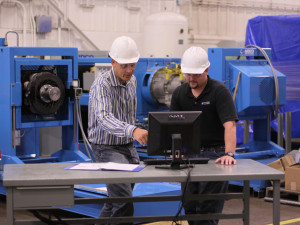 That means testing systems must be easy to learn and operate, as well as reliable in their results.
That means testing systems must be easy to learn and operate, as well as reliable in their results.
“A military testing and repair shop needs to have total confidence in the vehicles they’re sending back into use,” Classen said. “When we’re designing testing systems, we need to make sure a younger, less experienced serviceman can conduct testing as reliably as a seasoned person.”
Also different from the civilian world is the military’s need to receive new and repaired vehicles ready for full use – without an in-use break-in period. Power Test’s premier dynamometer systems fulfill the break-in process by simulating all of the operating conditions the vehicle could face, and provide field-ready vehicles right out of the shop. The break-in is a critical part of the testing process that, if not done correctly, could lead to a vehicle being out of commission and a serviceman out of action.
“We want everything to go exactly as planned, which is another reason we design our testing systems to be easy to use,” Classen added. One way that’s done is by having a common software platform across all types of testing systems. “A serviceman whose duty includes use of a dynamometer is likely to have a similar duty upon being transferred to a new station, but might be working with equipment to test different components. With the common software platform we provide, he or she can quickly get up to speed at a new station, working on different kinds of vehicles or different components. It doesn’t matter if they’re working on an engine, transmission, chassis dynamometer or hydraulic test stand; within 30 minutes, the serviceman would be able to fully run the testing himself.”
Along with wheeled and track ground vehicles, military depots use Power Test’s equipment for testing components on ships with power systems up to 10,000 HP, and aircraft, including unmanned systems.
Recoverable Assets
With operations throughout the world, the ability to easily establish engine or transmission testing in remote areas is required by the U.S. military and armed forces of other nations. Power Test’s fully containerized and transportable engine and transmission testing units respond to that need, and allow easy recovery of assets after deployment.
The U.S. Army and Marines have utilized 20-foot containerized engine and transmission dynamometers in war zones since the first Gulf War.
“A containerized unit fits in the back of a C130 for easy transportation into and out of fields of operation,” Kazmier said.
Power Test’s Wayne Mohler noted the containerized systems eliminate the need for a building and can be operated in locations that lack basic utilities – such as the middle of a desert.
Power Test’s Fully Contained Transportable Trans Dyno and the FCT Engine Dynamometer System each come ready to use in its own shipping container that doubles as a testing facility. It contains everything needed for testing, including all the testing components and a sound-insulated room for the data acquisition and control system.
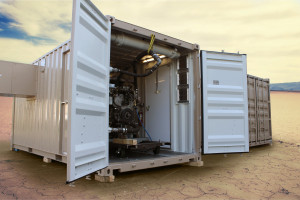 The FCT Dynamometer System includes Power Test’s 50X series dynamometer to testing electric motors, gasoline and higher speed diesel applications, with power ranges from 50-1,000 HP and speeds to 6,000 RPM.
The FCT Dynamometer System includes Power Test’s 50X series dynamometer to testing electric motors, gasoline and higher speed diesel applications, with power ranges from 50-1,000 HP and speeds to 6,000 RPM.
The FCT Transmission Dynamometer System uses AIDCO’s 450H Transmission Test Stand, the Model 265 Valve Body Test Stand, and the AIDCO ESC electric shift control. AIDCO is a Power Test brand.
The test container can quickly be relocated by simply disconnecting the non-spill hydraulic hoses and power extension cables.
Both the engine and transmission containerized units are paired with a containerized support unit for power generation, water recirculation, cooling, heat exchange and water holding.
While the containerized units allow armed forces to retain the value of the equipment, other initiatives seek to reduce operating costs or use of water, which is often an integral part of component testing.
Sustainability
Water shortages in some areas, and general government sustainability concerns regarding conservation are also issues for dynamometer and testing system manufacturers.
“Conserving water is very important to the current administration and to branches of the U.S. military,” said Mohler. “The U.S. National Guard, for example, uses water-free chassis dynamometers for testing multi-axle vehicles.”
Compared to a water brake chassis dynamometer, an air-cooled, water-free eddy current dynamometer uses no water and significantly less electricity. That eliminates the need for a water supply or a water recirculation system. The eddy current system uses just enough electricity to create the electrical field needed for the test. This is in contrast to a water brake system that requires constant power to run the pumps.
Reduced energy costs were not the initial focus of one nation’s navy that was seeking upgraded testing equipment, but Power Test came up with a solution that would recoup virtually all the power used in the testing of hydraulic pumps and motors. As part of a base renovation project, basic hydraulic pump and motor test stands were specified. The navy needed one unit for testing ship components and another for testing submarine components. Its existing system was old and crude, without variable speed, safety guards or other features. “It was really a dangerous system and had very limited capability,” Kazmier said.
Along with increased safety, the navy wanted to implement a fully capable testing system.
“There was a significant variety of hydraulic components they wanted to test, so flexibility was key,” Kazmier said. Power Test proposed a solution that would not only provide all the flexibility the navy needed for component testing, but one that would also result in a significant reduction in energy demand.
The HTS-100×2, dual 100-HP regenerative system, developed through Power Test’s Engineered Solutions division, recoups and reuses a majority of the energy in its operation. While it wasn’t an originally specified feature, the navy saw the energy savings as a bonus to the testing capabilities it was seeking.
“Our solution was a safe product with excellent flexibility, offering them complete control of any variable speed for the load or input,” Kazmier said.
Along with the containerized systems and custom solutions mentioned above, testing systems commonly used by military original equipment manufacturers and at repair depots include:
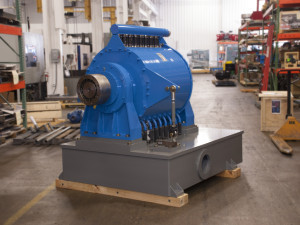 Engine Dynamometers — Power Test’s PTX Water Brake Dynamometer is used in multiple U.S. Defense Office of Logistics facilities, dozens of U.S. Army National Guard facilities, U.S. Marine Corps facilities and private industry repair depots that support the U.S. military via engine rebuild contracts. It is available in 500 HP and 1,000 HP configurations. The system features a through-shaft design that allows either end of the dynamometer to be driven and for dynamometer mounting systems to be attached and used.
Engine Dynamometers — Power Test’s PTX Water Brake Dynamometer is used in multiple U.S. Defense Office of Logistics facilities, dozens of U.S. Army National Guard facilities, U.S. Marine Corps facilities and private industry repair depots that support the U.S. military via engine rebuild contracts. It is available in 500 HP and 1,000 HP configurations. The system features a through-shaft design that allows either end of the dynamometer to be driven and for dynamometer mounting systems to be attached and used.
EC-Series Chassis Dynamometers — This heavy-duty chassis dynamometer features air-cooled eddy current load absorbers, therefore requiring no water or cooling system.
Transmission Test Stands — The AIDCO 450E transmission test stand supports testing of all Allison transmissions – commonly used in military vehicles, including some military-specific transmissions. Numerous military and private-sector repair shops use the AIDCO system. AIDCO’s Electronic Shift Control is used in conjunction with the transmission test stand.
All Power Test dynamometers and test stands interface with PowerNet 3.0 data acquisition and control packages.


